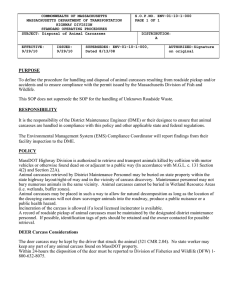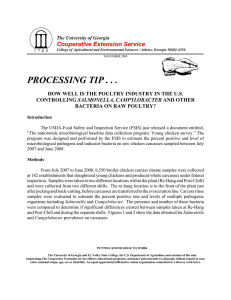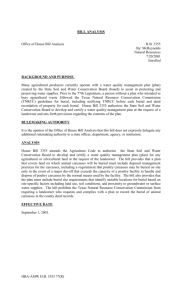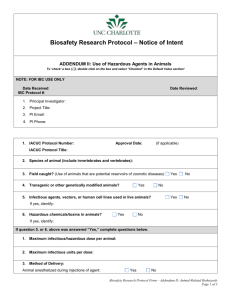PROCESSING TIP . . . Cooperative Extension Service
advertisement
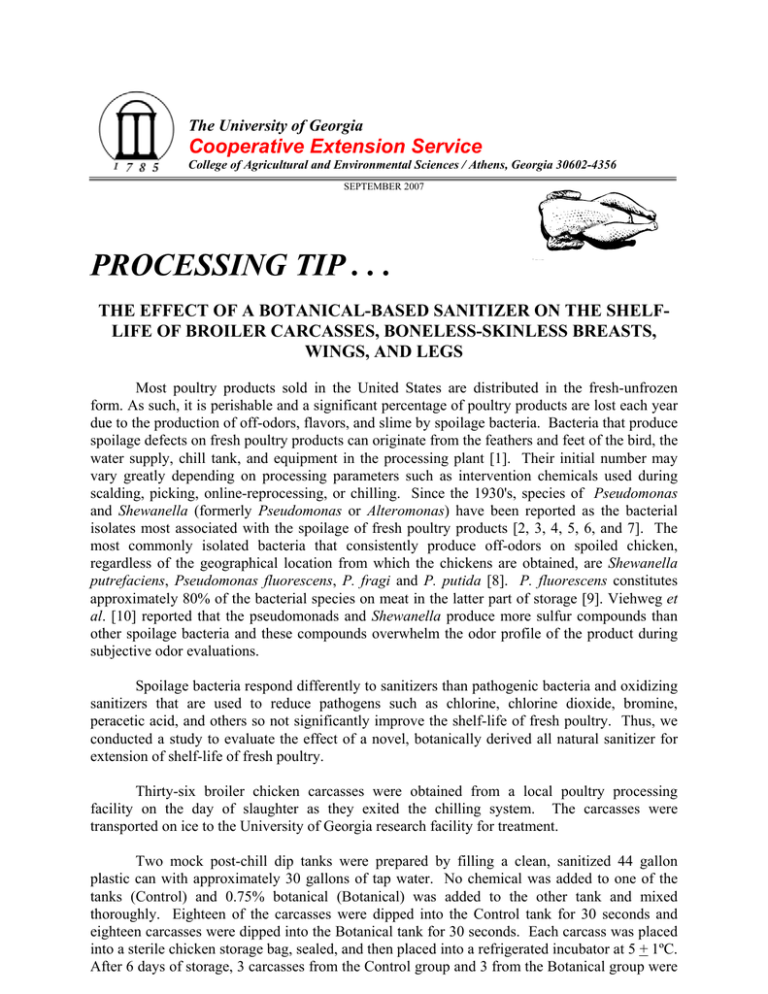
The University of Georgia Cooperative Extension Service College of Agricultural and Environmental Sciences / Athens, Georgia 30602-4356 SEPTEMBER 2007 PROCESSING TIP . . . THE EFFECT OF A BOTANICAL-BASED SANITIZER ON THE SHELFLIFE OF BROILER CARCASSES, BONELESS-SKINLESS BREASTS, WINGS, AND LEGS Most poultry products sold in the United States are distributed in the fresh-unfrozen form. As such, it is perishable and a significant percentage of poultry products are lost each year due to the production of off-odors, flavors, and slime by spoilage bacteria. Bacteria that produce spoilage defects on fresh poultry products can originate from the feathers and feet of the bird, the water supply, chill tank, and equipment in the processing plant [1]. Their initial number may vary greatly depending on processing parameters such as intervention chemicals used during scalding, picking, online-reprocessing, or chilling. Since the 1930's, species of Pseudomonas and Shewanella (formerly Pseudomonas or Alteromonas) have been reported as the bacterial isolates most associated with the spoilage of fresh poultry products [2, 3, 4, 5, 6, and 7]. The most commonly isolated bacteria that consistently produce off-odors on spoiled chicken, regardless of the geographical location from which the chickens are obtained, are Shewanella putrefaciens, Pseudomonas fluorescens, P. fragi and P. putida [8]. P. fluorescens constitutes approximately 80% of the bacterial species on meat in the latter part of storage [9]. Viehweg et al. [10] reported that the pseudomonads and Shewanella produce more sulfur compounds than other spoilage bacteria and these compounds overwhelm the odor profile of the product during subjective odor evaluations. Spoilage bacteria respond differently to sanitizers than pathogenic bacteria and oxidizing sanitizers that are used to reduce pathogens such as chlorine, chlorine dioxide, bromine, peracetic acid, and others so not significantly improve the shelf-life of fresh poultry. Thus, we conducted a study to evaluate the effect of a novel, botanically derived all natural sanitizer for extension of shelf-life of fresh poultry. Thirty-six broiler chicken carcasses were obtained from a local poultry processing facility on the day of slaughter as they exited the chilling system. The carcasses were transported on ice to the University of Georgia research facility for treatment. Two mock post-chill dip tanks were prepared by filling a clean, sanitized 44 gallon plastic can with approximately 30 gallons of tap water. No chemical was added to one of the tanks (Control) and 0.75% botanical (Botanical) was added to the other tank and mixed thoroughly. Eighteen of the carcasses were dipped into the Control tank for 30 seconds and eighteen carcasses were dipped into the Botanical tank for 30 seconds. Each carcass was placed into a sterile chicken storage bag, sealed, and then placed into a refrigerated incubator at 5 + 1ºC. After 6 days of storage, 3 carcasses from the Control group and 3 from the Botanical group were removed from the refrigerated incubator. Two technicians evaluated the odor of each carcass using the following scale: 1 = no odor was detectable, 2 = the carcass was questionable with regard to acceptability, and 3 = the carcass was unacceptable. Most people would reject a product with a 2.5 or greater odor score and the product would be considered spoiled. Immediately after recording the odor results, the carcasses were sampled with 400 mL of sterile neutralizing buffer using the whole carcass rinse procedure employed by the USDA-Food Safety Inspection Service (FSIS). Rinsates were diluted and plated onto total plate count agar. Plates were incubated at 7 + 1ºC for 10 days. After 10 days, the psychrotrophic plate counts were determined. The results demonstrating the effect of a botanical sanitizer on the shelf-life of broiler carcasses are presented in Figures 1 and 2. These tables provide odor scores and psychrotrophic plate counts (PPC), which are spoilage bacterial counts, for whole carcasses. Figure 1 shows that Control carcasses spoiled 4 days faster than those treated with the Botanical sanitizer. In Figure 2, the PPC data indicate that treatment with the Botanical did not significantly improve the counts and were similar to controls; however, the bacteria responsible for producing spoilage defects were not able to grow as readily on the Botanical treated samples. This is evidenced by the fact that no spoilage odors, slime, or discoloration was observed on the carcasses treated with Botanical; whereas, these defects were observed on the Control carcasses. Scott M. Russell Extension Poultry Scientist Extension County Coordinator/Agent “Your local County Extension Agent is a source of more information on this subject.”
